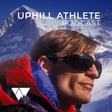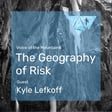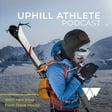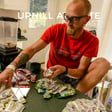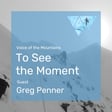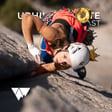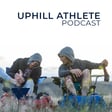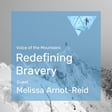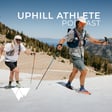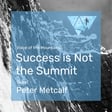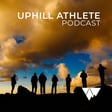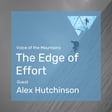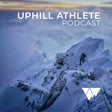Become a Creator today!Start creating today - Share your story with the world!
Start for free
00:00:00
00:00:01

Talking High Altitude Training with David Goettler
In this episode of the Uphill Athlete Podcast, Scott Johnston talks with elite alpinist David Goettler on a gamut of topics including David’s training history; approaching the big mountain ranges fast and light; the importance of base fitness; learning from failure; fitness versus pre-acclimatization; approaches for a pre-acclimatization “training camp” leading up to high altitude expeditions; the advantages and disadvantages of hypoxic tents for acclimatization training; David’s experience of attempting Everest without oxygen and the challenges of climbing in this style on such a popular mountain; training for marathons as a mountain athlete; and training in less than ideal situations such as a global pandemic.
Transcript
Introduction and Resources
00:00:01
Speaker
Welcome to the Uphill Athlete Podcast. These programs are just one of several free services we provide to disseminate information about training for mountain sports. If you like what you hear and want more, please check out our website, uphillathlete.com, where you'll find many articles and our extensive video library on all aspects of training for and accomplishing a variety of mountain goals. You'll also find our forum, where you can ask questions of our experts and the community at large.
00:00:30
Speaker
Our email is coach at uphillathlete.com, and we'd love to hear from you.
Meet the Guest: David Göttler
00:00:37
Speaker
Greetings, everyone. I'm your host, Scott Johnston, co-founder of Uphill Athlete. I'm excited today because with me is my friend David Gotler, alpinist, who splits his time between his home in Spain and when he's not an expedition climbing in Chamonix.
00:00:56
Speaker
And David and I have had the pleasure of working together now for, he reminded me just before we started recording that it's probably been close to five years now that we've been working together as coach and athlete. And it's been an interesting partnership. I think we've both learned a bunch of different things. And we're going to dive into some of that stuff today, what we've learned about training and
00:01:23
Speaker
and trying different methods. We've tried a lot of different interesting things I think that people might be curious to hear about in your training, David. And then also, I think we're going to touch on David's climbing accomplishments, of course, but also some of his own personal feelings about alpinism, the direction of alpinism, and what he's learned from all the expeditions to 8,000-meter peaks and the hard climbs he's been on, some of his partnerships.
00:01:53
Speaker
So I think it could be a pretty fun and interesting talk today. David, welcome. Thanks a lot for joining me.
Climbing Background and Early Expeditions
00:02:06
Speaker
Right. Well, why don't we start off with, you know, your name is going to be quite familiar to a lot of European listeners, but I think a lot of American listeners are not going to be so familiar with that name. Why don't you start a little bit, giving us a little bit of a background, but, you know, with how you got started in climbing, where you're from, and then some of your accomplishments, because there's, you have, maybe not all of your accomplishments will be here all day, but at least some.
00:02:37
Speaker
Well, yeah, I mean, I'm from Germany, from Munich. I grew up there and I got this kind of mountaineering, adventurous kind of, yeah, exploring genes, I think, from my parents. Every holiday we went to some kind of really exciting, like in the mountains, my father's a climber, we did,
00:03:03
Speaker
like almost kind of expeditions to the Sahara Desert or to Iceland to the remote parts of Turkey or Morocco in the Hayatlas Mountains and this was my childhood growing up like with these adventures and I kind of you know got hooked with climbing early on with Severn I started to rock climb and every weekend we had a mountain hut close to Munich and we went there and
00:03:31
Speaker
every weekend and yeah I got really yeah like the mountains were my second home and
00:03:39
Speaker
And I continued that journey and became, after high school, a mountain guide. I finished my kind of UYAGM certification when I was 23rd, so I was really young to work as a full certified mountain guide. And as well, I was a member of the German Alpine Club. They had a program for a young alpinist, something what Steve Howes set up in the US, like this kind of program. And I was a member of that.
00:04:08
Speaker
There, I went the first time on an expedition to a 6,000-meter peak in India, in Gaval Himalaya. It was to Changabang. We absolutely had no success at all. We almost didn't reach the base of the mountain, but I was so kind of like, hey, that's the thing what I want to do.
00:04:27
Speaker
And from that, this kind of journey going on expeditions and to the big mountains, yeah, like really kicked off. And in the beginning, I was a couple of winters, like our winter here, summertime in the Fitzroy Cemetery area.
00:04:43
Speaker
Climb for example super kind of later there which was really like an amazing climb and this was in the beginning of the 2000 years I think was 2001 2002 so there was absolutely it was almost empty there that we were the only foreigners we came really early in that season and now I haven't been there for a long time but I heard it's totally different than now and
00:05:06
Speaker
Then I really kind of totally focused to the high mountains, to the 8,000-meter peaks and 7,000-meter peaks in the Himalayas, in the Karakorums.
Pursuit of Oxygen-Free 8,000m Peaks
00:05:16
Speaker
And this is kind of my main target as well now, like climbing in modern style, 8,000-meter peaks. And for sure there, like I climbed so far.
00:05:30
Speaker
5,000-8,000-meter peaks, all without oxygen, all in really small teams, not with shepherds. But still, this is where I want to continue, and I don't collect all of the 14,000-8,000-meter peaks. That's not what I have in mind, but for sure, a couple of more would be really sweet.
00:05:56
Speaker
Well, and you, last year you got awfully close to tagging the summit of Everest without oxygen. And we can talk a little bit about that story later because I think it's kind of an interesting one. Not only your personal journey in preparing for Everest and that summit day, but also just your views on what's, you know, the tourism on 8,000 meter peak. So we've talked a little bit about before too. Yeah.
00:06:23
Speaker
And I think that your failure on that first trip to India, to Changabang, I think that's...
00:06:31
Speaker
I'm sure you would agree with me on this that you learned probably so much on that failed expedition that and a lot of people I think don't recognize how many failures top alpinists have, you know, how many times you have to turn around and go home and realize you are not prepared or the conditions are bad. Every time you go out the door you're not accomplishing the goal you set and I know that
00:06:58
Speaker
the height of my alpine climbing career, I'm sure that I didn't succeed more than about 25% of the time when I was headed out to climb. How about you? What have you found?
00:07:12
Speaker
Yeah, I mean, so far, I think I did 30 expeditions to the Himalayas, to the Karak Korom, like one to South America. And I have like a success rate from 50%, which is like sound to your 25, sounds really high, but still on even 50, I think like half of them were not successful is still something I think
00:07:43
Speaker
If you put in any other if you look in any other investment if you want to say so people would say 5050 sounds quite like a bad bet to really go with it so better pull my money out of that and And and we kind of invest in that and and also when I first kind of calculated this number really like success like like
00:08:08
Speaker
counting only when you really reached the summit or climbed exactly the route you want to climb. If I looked at that number, I was surprised how low it actually is because it didn't feel like that. Because so many times, like you said, expedition, which didn't went out as planned, weren't successful in the way of reaching the summit, brought me so much more
00:08:36
Speaker
Experience so much like and like push me to the to the next level of what i'm capable of doing and learn so much on it which i think. Is absolutely crucial and part of of mountaineering and i think also in general of if you wanna.
00:08:55
Speaker
and get better if you want to evolve and challenge yourself. If you don't fail, you actually don't kind of push your boundaries. You always stay really on the safe terrain. So you have to accept that.
Training Transformation with Scott Johnston
00:09:11
Speaker
Absolutely. Yeah. I think that one of the first, I think I want to talk a little bit about our history of working together and how we came together, but certainly, you know,
00:09:22
Speaker
The first big goal you had when you came to me, you were getting ready to go on a climb with the late Uli Steck. And that was a climb where you guys didn't actually climb to the summit of Shishapaima, but it was still, I think, an amazingly... You would probably count that. I certainly would count that as a successful climb because of the things you guys managed to do.
00:09:47
Speaker
But before we go there, I think we should talk a bit about that. Why don't you talk some about how we came together and how we started working together?
00:09:58
Speaker
Yeah, it was like so often in life or not often, but it was this kind of magical coincidence that some puzzle pieces kind of were fitting perfectly together in my life and as well on your side. So I was working, I got to know Steve Howes better because he asked if I want to join his Alpine Mentor Program as a guide in Chamonix. So I met him
00:10:25
Speaker
The same time I met Uli in Chamonix the winter before and we started kind of doing more things together. I knew Uli from like 99 to 1000 when I was in Patagonia with another friend and he was there and we kind of hang out, did a little bit of, you know, bouldering together and had...
00:10:44
Speaker
and one or two beers something like this but we never really kind of like we started climbing together and so it was the same this year and so I was meeting Steve Howard and then I said hey I just was kind of you know hooking up with Willie Steck and
00:11:03
Speaker
And I really wanted to step up my training and then Steve Howard said, hey, we just found an upper athlete and you should ask my coach Scott. And if he is the perfect coach for that kind of mission to get you fit for climbing with early stack on my 8,000 meter peak. And so I reached out to you and I was lucky that you still had a sport free in your busy agenda to take me on.
00:11:32
Speaker
And that's how we started. And from that moment, everything just went so fast. And in general, I have to say, this period when I experienced the kind of style Uli was moving in the mountains from our
00:11:50
Speaker
First time, this pre-archematization phase we did before there in the Kumbu and then went on the real expedition. I think we talked later about that as well a little bit more in detail from that. Then going on expedition, seeing his total approach, then how I could step up in this first, I think I reached out, I think must be like six months before our departure or eight months, I think.
00:12:16
Speaker
So we had like eight months to get me fit. These eight months, like how they transformed my fitness or put me there on a level I was like, yeah, I never knew this was possible. And so this was really like, for me, a crazy exciting time. And was this time when your experience, when you know this is kind of a pivot moment
Impact of Structured Training
00:12:42
Speaker
in your life. So it was really a good one.
00:12:45
Speaker
And I remember some, I know you've talked about this a little bit before in a video you made, you remember a few years ago, Steve and I did a workshop in Chamonix for people that were interested in training there with using uphill athlete methods and you
00:13:04
Speaker
put together a really good video for us to show at the beginning of that and and I remember that one of the scenes in that video is of you running in the rain with your Gore-Tex jacket on talking about how ridiculously slow you were having to train and but you'd finally kind of come to accept the fact that I gotta do this and I think that's a really challenging thing for a lot of folks is to realize that
00:13:30
Speaker
And for many people, they may have to slow down to go faster. And that was, I know that worked well for me.
00:13:39
Speaker
Yeah, I mean, this was the thing I always like, I considered myself as I always train, you know, like before I met you, I had some kind of logbook, I recorded on my watch and like the workouts and, but still I always did, of course, the things which kind of felt good and felt kind of also felt really like training and every time kind of, you know, pushed it in this kind of, yeah, like,
00:14:09
Speaker
fun hard kind of zone we call it now and where it really feels like how you do exercise but then for sure like I learned over the years now with you or especially in the beginning that going slower doesn't mean
00:14:27
Speaker
It's not training. It's the opposite. Like you need to accept this kind of, you know, that we have to work on the base to then kind of be able to build on that base, like really like have a stable base to build this really kind of sharp perimeter. And I do know that that first period we had to work together before you went to Sushipangma with Uli,
00:14:53
Speaker
there was a lot of bass training to be done. And that's all essentially what we did was just try to establish that bass. And now we've been working together for so long, your bass is obviously way bigger and you're much fitter in that bass intensity zone. You go much faster at those low intensities than you ever have before.
00:15:16
Speaker
And now it's been, I think, more fun for you as an athlete and more interesting for me as a coach these last few years to be able to sprinkle in some much more interesting training and, you know, some intensity of different types. And we'll talk a bit about some of those workouts that we've used over the years, different styles. And I know that Uli joined you in some of those workouts. I remember on the Iguiver when you guys climbed that with water jugs in your pack.
00:15:46
Speaker
that sort of thing. Yeah, yeah, of course. And he understood also this kind of approach of that you have this kind of slow and he, like when he did like there on the bird, you mentioned this was kind of when I joined him for four of his kind of 4,000 meter summits when he did his 82 summits projects in the IBS, like climbing all 4,000 meter peaks in the IBS in one go. And I joined him there for four of them. And yeah, like
00:16:15
Speaker
There, it was the first time really actually when we were not just like training together and training in the way of kind of running somewhere easy along or doing like a skimo session together when we really moved together in the mountains. And I was again there, I was always like the same when I went to Shisha Pangmar with him then later on, I was kind of like, oh my God, hopefully I could keep up with him. But what he was also, what he understood and was really good that he
00:16:43
Speaker
like kept in this zone, and of course his zone was there a little bit faster than mine, no doubt, of kind of not kind of exploding, but can keep that pace forever, for ages. And so he was there for sure on his kind of 82 summit projects, because he always moved and he didn't use any kind of, you know, no cars, no teleferics, just the bike and his feet for achieving that.
00:17:12
Speaker
he gained this was he said like his best kind of training he ever done more or less because he was this was all his all this kind of base training like working on the kind of yeah some one so and two because he for I don't know how many for 55 days I think in the end every day he just moved but not of course on this kind of top speed just moving yeah
00:17:35
Speaker
Yeah. And you know what you were, what you and many people do, and certainly a lot of the climbers I've worked with, and I was guilty of this before, you know, I learned all these things. And so with Steve, you can exercise at a very high level. You know, that's what you were doing. And then especially, I see this a lot with mountain guides where you're out all the time moving in the mountains and
00:18:00
Speaker
And it's just random exercise, but if you do enough random exercise, you can become very fit. But what I think you are exemplary of is that in your case, when we switched from a high volume of fairly random exercise to a much more structured program, you were able to attain a fitness level that you could never have achieved with that random approach. Would you agree with that?
00:18:30
Speaker
It totally for sure. I mean, this was for me the kind of the, this, this eye opening kind of, yeah, period. Because like I said, I had the feeling before I was exercising always and I wanted to improve and I, I saw it. I.
00:18:45
Speaker
I put everything in and I kind of flattened out before I never got better. I was like kind of locked into that kind of level of fitness I gained over all these years of being in the mountain, working as a guide, going on expedition, running, cycling, swimming, climbing, all of this, which I saw like, hey, I do so many hours, but I don't see any games anymore. And so I think this is
00:19:10
Speaker
Then when I started with you and with this kind of really structured, when I then would say, this is the first time I really train, and the one before was just like, yeah, like you said, exercising and then training with you, having this accountability towards you, having this kind of bigger scheme or having this prioritization, all of this.
00:19:36
Speaker
and there suddenly like we saw in the last years when i remember i don't know after two years or three years you said hey i think maybe now we know you reached maybe at one point you will reach your ceiling and that's it so but i think i am from the fitness and and maybe that's like what your
00:19:56
Speaker
ever capable of achieving, but I think like every year we again being surprised of like, oh, now it feels again so much better. And I go back to Nepal and I suddenly again take off another 10 minutes of something, which is kind of our test run there or test time there. And we both always like, oh wow, really this is good. And again, I learned faster. Yeah, I think that's a really interesting thing. Thanks for bringing that up because
00:20:26
Speaker
Obviously there will be some limit to being able, you can't just keep increasing forever, but it's interesting that even someone who was as fit as yourself can see these kinds of games, you know, year after year after year with the correct approach to training and people who are less fit than you will see even bigger games before they begin to get close to their genetic limitations.
00:20:53
Speaker
Yeah, I mean, for sure. But my first year, the games were crazy, and now they get kind of smaller and smaller. But still, I feel then suddenly in this very niche kind of...
00:21:10
Speaker
performances where I'm suddenly saying like, oh, wow, I never felt as good as in this or that kind of, you know, climbing with crampons on a 60 degree angle kind of, you know, like in Chamonix something or, or like suddenly being able that I run 40 kilometers and not feel destroyed and still could keep a good pace. And, and also with the kind of, um, yeah, like,
00:21:37
Speaker
Things we sprinkle in and we do like kind of the road marathon, for example, how surprised we were both when I suddenly had this kind of training which was totally new for me and we had to be really careful and so not to stress.
00:21:58
Speaker
But in the end, how could it transform to then mountaineering? Yeah, I definitely want to touch on that. But before we go into that area, let's go back and talk about that first trip to Sushapangma with Uli.
Shishapangma Expeditions: New Routes and Reflections
00:22:17
Speaker
I know you guys had a new route envisioned, but why don't you tell that story a little bit? I think it's a great story. Yeah, so the idea was to climb a new route on the south face of Shishapangmar.
00:22:33
Speaker
the face itself it's like I think is one of the best kind of eight cells meet the faces I know I mean just the base camp is amazing it's so remote there's no other expedition um at least in this kind of I've been there now two years and so the first year there was only
00:22:50
Speaker
only us and was really, yeah, like we wanted to climb this new route, but the weather was really messed up and we had super small weather windows. And so we switched to try again, Uli did this already before, but he said, like, hey, I want to try it with you to do again, she should pound myself's face on an existing route, but do it in one day, just with like from the base to the top and back, just with a run.
00:23:22
Speaker
backpack. We had this 10 liter kind of running backpack. At the beginning, this totally, really radical, leave everything behind, go as light as possible approach, scared me in a way, especially because I was with Orly Stack. He had
00:23:42
Speaker
had this kind of numbers of numbers of being like, yeah, he is the Swiss machine and he, he moves incredible up there. And so, and, but, but the good thing in general for me was the moment I started to be in the mountains with him, we really saw that our, our risk assessment kind of, and, and how we,
00:24:07
Speaker
how we determined like when we turn around or pushing further, we were really on the same page here everywhere. And this for me was super important to see because I don't want to go in the mountains and being like, you know, have to fight for like, hey, I think it's to avalanche and the other says, no, it's not. And
00:24:28
Speaker
And you just keep going because the other one is the famous one. And he respected totally my experience, which I had. I climbed, I think, more in the mountain in the Himalayas than he did. But of course, his kind of approach of being super light and playing that game was in a way in this kind of really super determined kind of consequence
00:24:58
Speaker
he did it was new to me. And I remember, for example, I said to him when we packed our bagpipes, I said like, hey, we should take like one AP gas cylinder and like super light stove and one titanium pot. I mean, it weights nothing. It was like, it's as big as this coffee cup, you know, all in total. And he said,
00:25:18
Speaker
David, if we take these things, we don't have to start at all because our backpacks just get too heavy. It doesn't work. And I said, okay, good. So we leave this home. But we knew by choosing this style, having nothing in our backpack, then a pair of little bit warmer down clubs and another down jacket, that was it. We had 10 bars of jazz and one and a half liter of drinking for the whole kind of climb. And that was it.
00:25:47
Speaker
And by choosing this style and accepting this kind of set of rules we put upon ourselves, we knew we have always to turn around at a time when maybe normally we would push further when we knew there would be a tent somewhere waiting for us or fixed lines or any kind of backup thing. And there was nothing.
00:26:16
Speaker
We tried it then the first time, we had the Gerona route there up and we came pretty close, but we set ourselves at three o'clock, wherever we are, we turn around. Doesn't matter how close we are. So we arrived at 7,800 meters, so it's just 250 meters below the summit and we turned around there because we knew there was this
00:26:43
Speaker
very kind of, it's a long kind of flat area there on this kind of summit plateau. And we know it was heartbreaking and it takes so long, this 215 vertical meter take ages up there. So we said, okay, we turn around, we went down and arrived back at the base, yeah, like totally fine and good. And so
00:27:07
Speaker
I think in general, where people really need to take care, also here in the Alps, for example, and I guess in wherever people are in the mountains, it's the same.
00:27:23
Speaker
you really need to play to the rules you kind of choose and accept. If you take nothing with you, then you have to play the whole game of mountaineering in a different way and you also need to be prepared differently.
00:27:41
Speaker
Mentally, but also physically, of course. And so you can't just see somewhere in the news or on Instagram that you kind of, you know, oh, this person climbed Montblanc or Everest or whatever mountain or Denali in a crazy fast time. And then you try it.
00:28:01
Speaker
and don't be prepared as well as this other person who did it. And also knowing that you have to turn around if you don't match this and this and this kind of time, that you have this safety margin. And in the end, I think it's not any riskier what Uli and I did there on Sisapangma than
00:28:23
Speaker
than or is less risky than so many other people I see out there in the mountains would take way more risk. Often they just don't know that they take so much more risk. And they're carrying a lot more stuff often. Yeah. Yeah.
00:28:40
Speaker
The last time I did something like that was with Colin Haley, and Colin and I, our goal was to do a single push climb of the Cassin Ridge. This was in 2004 or 2005, I think.
00:28:59
Speaker
And we had acclimatized on the standard route on Denali, and we're feeling quite good. And we started off on that single push effort on the Cassian Ridge. And we did have a little stove and a pot to melt water, to melt snow and make water. And we each had a small pad so we could stop and sit on it and take a little rest. But we had no sleeping bags. Like you, we had the down parka in our
00:29:28
Speaker
our pack. And the difference, of course, with Denali and the Himalayas, you can climb all night because the sun never goes down there. But we encountered terrible conditions. Places that we thought we were going to be just kicking steps in snow turned out to be black ice. And we each only had one ice tool. And so we were moving much slower.
00:29:55
Speaker
At one point, we just said that we didn't have enough gear to get, you know, if we got much higher on the route, we wouldn't have been able to get back down. And we realized that this isn't going to happen. So we just turned around and and went home. And I think that's a
00:30:11
Speaker
That's something I learned a long time ago in my climbing career was to fail, I guess I would call it for failing successfully. It's one thing to fail. And the other thing is to fail and get home safely and learn a few lessons and have it be under control rather than out of control failure. And I think that's when it can get really dangerous.
00:30:35
Speaker
Yeah, totally. And I remember they only always said, you know what, it's really important that we don't epic up there, like totally, you know, like, and, and this is what I see so often. People, people, it's just like, they go out there and, and it's a blueprint for having ending in this huge epics. And in the end, this huge epics, they even get kind of turned into some heroic kind of mission they achieved. But in the end, I'm like, Hey, it's, it's not,
00:31:05
Speaker
Why it is kind of something we have to applaud if somebody survives on an eight day kind of be working from one to the next place and just don't turn around when you're like, hey, come on.
00:31:22
Speaker
This is, or at least it's not my style of how I want to move in the mountains and it wasn't the one from Uli and coming back to Shijepammer, I just want to add one thing. The other thing what I really learned on this expedition was that
00:31:38
Speaker
Before on all my 8,000-meter peaks expedition, I had this approach that whenever I'm not on the real mountain, on the objective I want to climb, then I just rest and stay as quiet as I can be to take care of not losing energy. And this was really changed completely to the opposite, and it felt so good. So this means that
00:32:07
Speaker
Even starting from the happy monetization, which we did in the Congo there the first time, and then we moved to Xi Jinping, which is in Tibet in China. We really pushed ourselves there with running around, with kind of trying to really go as fast as possible to 6,000 meters and back. And running in two days from Lokla, the Anamche to Chukum, for example, which before I did in a
00:32:35
Speaker
kind of seven day trekking with like a rest day here and a rest day there. And the same for waiting in base camp for a good weather window. Normally, like I said, I wait there in base camp. I remember on Lodze in 2009, I think, we had this 18 days of bad weather and I moved
00:32:56
Speaker
like 50 meters out of our tent to have a coffee in the next base camp, like set up there in on Lutze. There are many expeditions to every space camp. So this was the maximum. Otherwise, I just was sitting there and did nothing just to kind of don't get, you know, tired legs. And we're really every day we did something. We we went for a kind of, you know, two, three hour loop around the base camp, went up to six thousand meters. We're just running shoes up and down and moved.
00:33:26
Speaker
And in the end, this felt so much better. For me, I felt the first time that I was really all the time kind of...
00:33:35
Speaker
in like in not this kind of you know fatigue and and kind of like a slos i think this is the best way to put it like normally on this base camps you feel so often like totally like a slos and is everything is kind of takes energy and then at one point you switch on your engine and you go up the mountain and back but then again to slos mode and
00:33:56
Speaker
and there was so good to feel energized and you're kind of moving and you did, I do yoga and base camp, I do stretching and all of this and I kept this and since I do this since like the last five years now, every time I improved my performance on the mountain but also I feel really when I come back home
00:34:20
Speaker
I immediately can start again, go for a longer run, feel not this totally depleted state of mind and body. You and Uli went back on that same trip. You climbed another route on the South Face, right? Yeah, exactly. We did our Spanish Gerona route to 7.8 and then we came back and
00:34:48
Speaker
And then we were like, Hey, what's now? Like, that's it. We go home now and, or we wait and we were like, okay, let's see like in two, three days how our boys feel. And after three days we were like, Hey, I don't feel so bad. Let's, we should wait a little bit longer and maybe see if there's coming another weather window.
00:35:06
Speaker
And so after eight days, there came another weather window, like again, like 24 hours, which looked kind of okay to do something. And again, we went out and tried to climb the Scottish route on the south face in one day, like same style. And again, we only came to 7,600 meters because the upper part was again, really deep, like snow. It is this cooler and it was way more kind of trail breaking than we saw it.
00:35:36
Speaker
And as well, the weather turned again bad and it started to snow and you have this 2000 meter phase, like it's like the Eigen Norse phase. And if there's only some small snowfalls, you have these huge galleys which immediately turn into really dangerous places from Spin Drift and Spin Drift and not anymore Spin Drift.
00:35:57
Speaker
rapidly it gets like a big avalanche and so we turned around there but but I remember up there when we said make the decision okay it makes no sense we turn around from the conditions from the weather we still felt really good and early just said like hey this was really a cool trip you know what at least we moved a lot so and that's true so we we enjoyed this kind of moving together there and for me it was yeah like an eye-opening experience
00:36:27
Speaker
And I remember I came back to base camp and I knew that's exactly the style I kind of want to go and try to push further and also come back to the south phase as soon as possible. And, you know, I know that somewhere buried in my computer and probably on yours, I know on yours too, that we have that little video clip of you and Uli reaching the high point and then deciding, well, we've got to go down.
00:36:57
Speaker
And I think we should try to resurrect that and get that on the website. I think people wouldn't. Yeah, we can. We can. I have it somewhere. I send it over to you. We put it up there. Yeah, it's a very, I loved it. I mean, you guys sitting there together in the snow talking to each other, you know, it's one of those, it's another one of those moments where it was a very successful failure.
00:37:19
Speaker
Yeah, exactly. That's how I totally see it as well. And of course, you also see there in this moment that we are, that we are, of course, one part of us is also frustrated and sad that we don't
00:37:33
Speaker
Because in the end, we want to go there and be successful in the way of reaching the summit. But actually, at the same time, we know that part of this game of high mountains and mountaineering in general is this kind of gaining experience in failure.
00:37:55
Speaker
And then you did go back fairly soon. You know, was it the next year or the year after? Yeah, it was right away the next year. I just like, I came back, I remember, and I was like, hey, I need to go back next spring. And Oli was busy already because he had this long time plan kind of expedition to Everest, Loetze. And he said, hey, you should go. It's really good. He climbed Chi-Chapanga already, so it was,
00:38:23
Speaker
was for him, absolutely. This was the other thing of early, that he was so happy to share his knowledge and also see that people kind of take that approach. And he was so hungry for also exchanging this information and asking like, hey, how do you think
00:38:42
Speaker
hey we can kind of get better in this in this field and and reaching out to also totally different disciplines which is something i think which is really really valuable and always good to not sink in this kind of only mountaineering has to be like this and it's only in this kind of
00:39:00
Speaker
you know brackets to sing so um and and so yeah i i reached out to have a mass it's an italian climber mountain guide he's also a north face athlete and so we we hooked up together for going to shish japanma then just the next year and
00:39:21
Speaker
And this was again like this amazing expedition and we tried it again to climb it in one day. And actually this time we were successful in the way that we really reached the just five meter below the summit where we turned around at that time.
00:39:38
Speaker
because the last 10 or 15-meter vertical and 5-meter up was this really totally avalanche-grown kind of druggers with huge cornies and we didn't, we only had a very short, like, Kevlar row massage, so we couldn't do any kind of belaying. And the moment we kind of entered the slope, you hear this kind of
00:40:00
Speaker
Boom you know like that the whole kind of slope settle down and we're like oh no this is super loaded and and we just had no chance to delay it in any way so we are both
00:40:11
Speaker
like lifetime mountain guides and we didn't know what to kind of, you know, had any kind of trick there left. And we said, hey, for us, this is, we achieved, we climbed this 2000 meter phase in one day. It took us 12 hours, 11 hours, I think. And then, yeah, but again, we learned from my experience before and also how they was never
00:40:37
Speaker
eight thousand meter peak or never an eight thousand meter and so we adjusted a little bit because this is the other thing I think with failure comes
00:40:47
Speaker
the kind of responsibility that you have to reflect and analyze and learn from it. Because if you just always fail, fail, fail on always the same topic, it's kind of, yeah, it's you put a limit on yourself, it's actually stupid. So you need to kind of analyze, reflect what went wrong and try to get better on these things. And so this time,
00:41:12
Speaker
We took a small tent for us to have this backup that we didn't have to turn around at three o'clock to get off the mountain. So this time we took the small tent, we stacked it at 7,600 meters, and then we continued and we reached the summit or just below the summit at six o'clock in the evening, which was amazing.
00:41:35
Speaker
And it was no wind. We were the only person on the whole 8,000 meter peak there on Shishapangma, not even on the normal route on the other side. There was nobody and it was like one of the best feelings out there. And kind of early, early, the other thing was that exactly in that year on that kind of spring expedition there, it was the year when early died on Nuksi. So I was in base camp of Shishapangma.
00:42:03
Speaker
when I got the notice where he died on Nuk Tse. So and I was exactly at this place where I learned so much from him and he was the year before with me here and then we kind of honored his kind of life in the way that we climbed Sisapanga and the style he taught us and so this was really like for me kind of very yeah like one of the best moments being up there
00:42:28
Speaker
We have a sinking rod early and kind of achieving that, but he kind of, yeah, what we tried the year before. And so, yeah, and we went down safe. And so this was like, yeah, for sure, one of my best expeditions. Great. Yeah, that's a wonderful story. So one of the things that you mentioned earlier, and I think we should talk about this, was your, the pre acclimatization trip you did with Uli in the Kumbu region.
Pre-acclimatization Strategies for High Altitude
00:42:56
Speaker
And
00:42:58
Speaker
This is on the south side of Everest for people who don't know that geography very well. And you have subsequently used this several times now. We have planned what in a normal sport would be called a training camp. And you have gone back and done this exact same thing multiple times. The most recently with two of the other mountain runners that I coach, Luke Nelson and Mike Foote,
00:43:27
Speaker
And so why don't you talk a little bit about how that how that's worked for you and then I'll talk some about what we learned I mean or how you improved and we've seen dramatic improvements each time you've gone back there. Yes I mean for for me climbing 8,000 meter peaks
00:43:44
Speaker
I really want to climb them in a fair style, which means, for me, foremost, don't use bottled oxygen. So I need to get very well acclimatized for the eight Salsimeter piece.
00:44:01
Speaker
Previous, the period to get acclimatized for base camp height more or less, up to 5,000 meters, felt always the period where it was really the most
00:44:17
Speaker
difficult one or also the one who took the most kind of energy and kind of depleted you in a way. So with that, we were thinking, how can we kind of change that? And then we came up with this idea that we go
00:44:37
Speaker
Before our real expedition, we go two weeks to this kind of so-called training camps, like high altitude training camp, to the Kombu, sleep there at an altitude of 4,700 meters in Chukom, in a really nice kind of lodge, a really very comfortable setup. It's not a tent, it's like you have all the comfort you need, you have a warm bed, you have a nice
00:45:03
Speaker
warm um um yeah dining room and and you can really recover very well and then during the day you you push yourself and kind of run hike things to up to 6 000 meter there it's island peak or chukumri or this kind of mountains they're like easy trekking mountains and then after these two weeks we come back to the albs or you
00:45:29
Speaker
if you are somewhere in the States, you go to a higher place. And then again, you train at a home and try to keep that altitude here and there, like sprinkle it in, like in the Alps, I have the, in Chamonix, I can go up with the Telferi, two huts, which are 3,800 meters, sleep there for one night, also can go up to the summit of Montblanc, 4,800 meters just for a day trip or things like this. And, but I sleep kind of low. I sleep at Chamonix is like a thousand meters.
00:45:59
Speaker
Hi. And so I can again train strings and kind of work on my strengths part. And then after four to five weeks, I go back on it on the real expedition. And the first time I did this was amazing. And now we kind of tweak it and get better in it even to like how immediately you jump back into your kind of 5,000 meter base camp acclimatization. So you can kind of
00:46:24
Speaker
leave out all this kind of super slowing you down and depleting your part of the expedition and be just right on. And this is, I think, a field in general where we also in the future can even learn more and get better. And I think one thing that will probably
00:46:46
Speaker
drive a point home how fast you're moving there. Besides, we can talk a little bit about your climbing times on Island Peak, but also you guys typically fly into Lukla and then get to, from Lukla to Chukkung in two days, right? And how much elevation gain, roughly?
00:47:10
Speaker
Well, Lukla is at 2,800 meters and you go a little bit down to 2,600 meters and then it goes to Chukom 4,700 meters. So it's like a little bit by like, yeah, 2,000 vertical meters of elevation gain. But before, like I said earlier, like normally you do this in six days or something like this, which normally you track.
00:47:35
Speaker
and like one day maybe if you're already kind of fast to Namche then you have a rest day in Namche Basar at 3600 meters and then the next day in kind of two days or three days you trek to Chukom and and actually we figured out that it don't have to be so slow and and at least for us and this is the other I think really kind of you know like
00:48:03
Speaker
and like how you say like the caveat on that whole acclimatization thing is that it's so individual and men that kind of 600 vertical meter per day and and it's like for some people this is even that might be too fast this 600 meter but for other people this is like you can push way harder so
00:48:28
Speaker
with altitude you really need to take care but you can also really experiment how you deal with altitude and it's very individual but for us it absolutely worked and so far like you mentioned this
00:48:45
Speaker
spring just before the kind of world lockdown on Corona, we were lucky and we just kind of squeezed in this kind of training camp with with Luke and Mike and Mike Arnold as well, like food and Mike Arnold. And all of them never moved so quickly in altitude.
00:49:07
Speaker
But I said, like, hey, come on, try this. I'm sure it works. And for all of them, it worked perfectly. And none of us took any kind of no drugs, nothing. So I think this is the, yeah, like you have really to see how you deal with altitude.
00:49:26
Speaker
Sure, sure. And it certainly doesn't hurt that all four of you had a very strong aerobic base. They were all very fit guys. And that makes, of course, I mean, I think we can agree that we will talk a little bit about fitness versus pre acclimatization. I know you're a big believer that the fitness is the real big key. You've got to have that base of fitness. But when you first went there that very first year, I remember I was quite impressed when you and
00:49:56
Speaker
and Uli did Island Peak round trip from Chukung. It was quite fast, like seven hours as I recall.
00:50:05
Speaker
Yeah, I think there was something like this. Yeah, I think like seven or just under eight hours, something like this. And then subsequent years, as you've gotten fitter, we've been able to use that as kind of a measuring stick now. We know how long it has taken you. And I think your time, I can't remember your fastest time, but I believe is down close to six hours now.
00:50:31
Speaker
Yeah, I think the fastest time was something that I really would need to look, but I think it's five hours. It was really close to five hours, something like this. But again, in the mountains, this is because I just read, I sing words yesterday, I sing.
00:50:51
Speaker
or today, I don't know, like I posed of Kilian Jornet, he posted something about this kind of times in the mountains and or fastest known times and and records and all of this that again here it's it's kind of it's even difficult to compare like from my own performance from one year to the next because one year I was with somebody so I moved with Willy and Willy is super fast but just as a team you immediately start I think to move
00:51:20
Speaker
a lot of times slower because one is kind of taking a break here, the other here. And so, and you just cannot go in. Yeah. And always in your rhythm. And so, so, and then the next year I did it alone. And so it's then different and then condition changed a little bit and all of this. So, but I was, I was surprised like how fast it is. Yeah.
00:51:42
Speaker
I don't think we can, it's not like comparing, um, you know, record road racing running times and that sort of thing. We can't do that because the conditions make a huge difference. But I think that the fact that, you know,
00:51:55
Speaker
I'm thinking more in the big picture of the fact that you're doing this in less than half a day. And for most people, it's kind of a big expedition. It's a pretty big undertaking to go there. And I'm not saying that to put those people down, but I think that the point I'm trying to get across is you can only do this because of that fitness that you've developed over the years.
00:52:21
Speaker
And if people are interested in learning more about that, we have quite a good article on the website about the second one of those training camps that you, Erve and Uli did in the kumbu. People can read a little bit about it and see how you are performing there because I think it can be instructive
00:52:42
Speaker
not so much that it needs to be a person's goal to match those times or to beat those times, not trying to create a race out of this, but more to just show what's possible.
00:52:54
Speaker
And it's kind of like what, what Uli did with you was show you what was possible. And I think that what this, what we're trying to do with people with our, the message we're trying to get out there is to show what's possible. Not that we need to be the next Uli Stik or that we need to be the next Killian Jornet. I mean, that's incredibly gifted people that could do that sort of thing.
00:53:17
Speaker
But it does show that with the proper approach, we can usually do a lot more than we thought we could do in the past.
00:53:26
Speaker
Yeah. Yeah. And I also think it's too often or I see it on mine. If you do something for such a long time, which I did like doing this expedition, like 8,000 meter peak expedition, you start to have your system and then to break out of this system and try something new is sometimes almost impossible. And you need this external kind of
00:53:49
Speaker
influences or inputs that you suddenly change your perspective or try something new there. And I was always scared before moving so fast because I was always like, oh my God, I mean, I'm really dealing well with attitude, but I had to move so fast from without acclimatization to 4,700 meters and speed there. It seems to me before really risky, but
00:54:16
Speaker
but actually once i tried it it works really well and now i did it a couple of times and just like this spring for example i was i was um or no it was the fall it was like fall 2019 when i went on an expedition i i was before because in the summer i'm in spain at sea level here and
00:54:39
Speaker
I had zero acclimatization, you remember, and I went there. And again, in two days, I went to Stockholm and I was surprised how little kind of I didn't have. I had a slight headache and I didn't have this kind of sixth year feeling that you can really push, but I was okay. You know, after one night at 4-7, I felt absolutely fine then. And like I said, I'm
00:55:04
Speaker
It seems that I deal well with attitude, but still here I was surprised how good that went.
00:55:12
Speaker
And so I know this is something you want to talk about, and that's pre-eclamatization using something like an artificial hypoxic environment, like using one of these hypoxico tents.
Debate: Hypoxic Tents vs. Recovery
00:55:27
Speaker
And let's talk a little bit about your experience with that. I know you and Uli have tried those things, and Steve and I have tried them.
00:55:35
Speaker
And we've written a bit about it on the website, but tell me about your personal experience using that pre-acclimatization method. Yeah, I mean, I get asked a lot about this.
00:55:49
Speaker
kind of shortcut to acclimatization, if you want to say so, with these tents. And of course, it also caught my attention when it kind of became a little bit more popular, because actually it's there for quite a long time, I think. You know, this system is super long, I think. Yeah, I started my first experiment with using the hypoxic sleeping
00:56:12
Speaker
was in training cross-country skiers in the mid-90s. And my own personal experiments with it were around 2000. Steve and I tried it before we went on a climbing trip together to Tibet.
00:56:28
Speaker
I have a little bit of experience with it. It's super long there. This is already kind of one sign to me that maybe it doesn't do as good maybe as it's hyped at the moment. If something is so long really around, if it would be really absolutely the shortcut to cut out this part of shitty acclimatization up to 6,000 meters, it would be way more popular.
00:56:53
Speaker
And still it came up and it kind of becomes suddenly fashion and everybody talked about it. So I also tried it. And in the end, it didn't help me in the way that it totally sabotaged my recovery because just sleeping in this tense, even I tried the one where it's just like the head tensing.
00:57:18
Speaker
or then the full over the bed, just the moisture inside, the shitty air quality, it was always really hot. So this kind of sabotage, and then of course the kind of low oxygen, like sabotage my recovery and my sleep quality, which is really important for me. And so by that, I couldn't train hard.
00:57:45
Speaker
It's the question like what is more valuable for you than like putting more really good quality trainings in or having this little bit of optimization. The other thing you really need to do it for six weeks, super consequent and consistent and don't skip a night somewhere else. So this was for my kind of lifestyle where I travel a lot and be around. It's also really complicated to do that.
00:58:14
Speaker
And then once we figured out this kind of two weeks of pre-acclimateization in the combo, this was for me way better. And I know this is a very kind of, yeah, fortunate and luxury that I have this time and can put that in because I'm a professional athlete. I know many people who have like a normal job cannot go just like two weeks before to the combo. But I think you might,
00:58:44
Speaker
Yeah, think about places which are closer to your home, which are higher and go there and do your pre-acclimateization there in a similar way, which we do in the combo. For example, I was just like before the whole lockdown as well. I was the first time in Aspen and I said, oh my God, this is the best place. And I kind of, you know, after maybe the combo where I knew like, hey, you could do such a good
00:59:08
Speaker
pre-acclimateization or somewhere around Lake Tau where it's also really high. So I think there are more places than you think where you can do this kind of pre-acclimateization period in a real high altitude environment instead of this artificial chamber. And like I said, to me, it didn't brought any real benefits.
00:59:30
Speaker
And I think that's certainly the conclusion that Steve and I have come to in working with most athletes who want to use the sleeping in a hypoxic environment is that it has such a negative impact on their ability to recover and absorb all the training that you have to cut way back on the training load. And if you do that for a month and a half,
00:59:56
Speaker
that person's going to lose quite a bit of fitness. And so I think it's certainly something still have to weigh in balance. Exactly. And but in general on all these things, like from hypoxica to using oxygen, and I think here we have to start to make the difference, like we have to difference between like, do we talk about professional athletes who
01:00:21
Speaker
who go on expedition or do we talk about like the clients I guide and they go on expedition or you go on a guided trip because there maybe this hypoxic system might do something and even if it's just this bless you effect which is an absolutely okay effect you know it's like
01:00:42
Speaker
If so many people I see the first time when they go to altitude, they're so stressed about getting altitude sick that they get altitude sick actually, because their body is such like, oh my God, oh my God. And I think this cough is now the beginning of a pulmonary edema and so on and so on.
01:01:01
Speaker
And if you slept six weeks in this tent and you get a change in your blood combination and you get more red blood cells, for sure, I think this is like you are the better expert.
01:01:18
Speaker
some parameters you can measure that they change to the good. But I think the most for change is that you are way more relaxed in altitude. You arrive there and you have this confidence of, hey, actually my body is doing well at 5,000 meters because I slept in this tent and so I'm way more relaxed. And this is all like 80% of the people need to then do also okay on the mountain.
01:01:42
Speaker
Because then anyway, most of them, they put on an oxygen mask at 6,500. And then anyway, they never exceed above 7,000 meters more or less. So for them, it seems maybe a good tool. But for me as a professional athlete and wanting to go there in this kind of to me fair style without oxygen and
01:02:07
Speaker
And moving kind of fast in the mountains. It's, it's a different kind of, yeah, like topic we talk. Sure, sure. And let's explain that just to real quickly go back to when you say they never go over 7000 meters and what what you mean by that, I believe, is that.
01:02:25
Speaker
the flow rate of the oxygen that they're breathing can lower the summit of Everest to close to 7,000 meters. And so that means that they never have to fully acclimatize to 8,000 and higher. They're gonna be, because they're never gonna go above an altitude, an effective altitude of 7,000 meters with regards to the atmosphere they're breathing.
01:02:51
Speaker
Yeah, exactly. This is like what I meant with this. And I don't want to kind of, you know, I don't want to sound arrogant in the way or diminish like the experience these people have because the beauty of mountaineering in general is that everybody can choose the style you want to climb. We have not like our official book of rules, like in any other sport. So that's the beauty we have. So the only thing we really need to do is to be
01:03:17
Speaker
honest back in how we move there, how we achieve something. And then I think, especially in this 8,000-meter peak climbing over the last decades, there was this kind of two fields of professional
01:03:35
Speaker
mountaineers who try to push the boundaries in whatever way. And then the kind of commercial side of it, the guiding part, just kind of blurred a little bit into each other. And so we have this overlapping where people actually don't see what is
01:04:00
Speaker
what is happening here in a way or where they themselves are really on this kind of scale from being self-sufficient up there without oxygen and be able to move on the mountain without a help of a guide or a shepherd and fix lines and to the ones who the first time see a mountain and we have all this wide spectrum. And everybody can go there, but
01:04:28
Speaker
But yeah, I think there we need always really to take care of what kind of people we're talking to and also about and when we put out this kind of how you can move really fast there or do the acclimatization and all of these things.
01:04:44
Speaker
And so while we're on the subject of Everest, let's talk about your trip to Everest.
Everest Without Oxygen: Challenges and Decisions
01:04:50
Speaker
I know that that's not your normal kind of climbing expedition that you would go on to go climb the crowded route on the highest mountain in the world. What got you to Everest and what made you decide that that was a goal for you?
01:05:07
Speaker
For me, all my goals I have, I look to something and see what attracts me, what challenges me, and Everest is something I always want to climb. I knew on the other hand that it's one of the busiest mountains we have.
01:05:28
Speaker
But I also knew that from many stories people tell me that climbing is without oxygen is something, everything must be really perfect and really strong other mountaineers who were trying it for again and again and couldn't succeed. So I had huge respect for that. And so I said, okay, I want to choose it.
01:05:53
Speaker
without climate, without oxygen, climate without a shepherd who helps me carrying my stuff up and down, but going to the mountain when it's kind of from the conditions the easiest. And of course, I also benefit there from all the other expeditions there.
01:06:11
Speaker
And it's also their right to be there and everybody, like I said, can do it the style they want. So I went in spring 2019 to the normal route, to Nepal, to the Kumbu side and tried to climb Everest in the style form, which was for me kind of an okay style. Yeah.
01:06:35
Speaker
Let's talk a little bit about that because I think that it was interesting for me, you and I were in daily contact while you were on that trip. And I was seeing you were right. You're, you're entering all of your, your days into training piece. And I, we could text one another pretty frequently. And it was, it was impressive to me how fast you were moving between base camp and up the mountain.
01:07:01
Speaker
And I think you were feeling very, very good. So what happened on the summit day that made you stop 50 meters below the summit? Yeah. I mean, it was like, it was for me again, like.
01:07:14
Speaker
one of these kind of amazing expeditions where I didn't succeed but I learned so much and it was such a successful experience in the way and like I said I knew there were a lot of other people and this could be one of the factors why I couldn't make it to the summit and again I didn't want to pick up there so for me in the end
01:07:36
Speaker
I this year to spring 2019 had a very few good weather days so in the end it boiled down I think to five or five and a half like really days where it was possible to climb Everest and then out of these five days you need even the better ones to choose for climbing without oxygen.
01:07:56
Speaker
and also don't have a shepherd which have spare oxygen in the backpack and it's just right behind me. When I kind of need it, then I can get it. So with this kind of style, I also could push way further. And so for me up there,
01:08:12
Speaker
experience this kind of massive traffic jam which was all over the media and I was like this famous picture was I think on the 22nd and I was on the 23rd so I was just the next day and but it still it was way too many people and when I arrived at
01:08:28
Speaker
at the south summit and there's a small kind of dip down, I saw this line of people coming down and I tried to be really late because first of all I wanted to be in the sun and not climbing through the whole night because all the other people they start like at 10 o'clock in the evening before and they go through the night because with oxygen the one main difference is that you are so much warmer.
01:08:53
Speaker
I didn't want to risk that I have to turn around because it gets too cold, so I started really late and this gave me up to 8600 meters from the south.
01:09:08
Speaker
South Skoll, I was alone, was amazing. I did really nice progress there and moved good. And then slowly the people coming down, but they were way slower than I hoped. So still there was like at the crucial part between South Summit and Main Summit is where it's this sharp ridge and you
01:09:27
Speaker
you can't overtake everybody is so busy with themselves they have the mask on they everybody is in this kind of alien mode and totally kind of like yeah like they they don't they're not able to step out of the out of the track and and also just overtaking
01:09:44
Speaker
they don't see you they kind of it was for me to risk it to to stand up there in line and and depend suddenly on all these people how they move how they let me pass or not pass especially the moment when i said hey i want to get off this mountain when i want to turn around so
01:10:03
Speaker
So a hundred meter below the summit at 8,750 meters, I pulled the block and said, okay, that's too busy. And so I turned around, but like I said, I felt good. I mean, of course it's like, it's exhausting and it's so much, the higher you get, the more it is not your actual kind of like muscles or fitness, it's your brain and your willpower and your kind of motivation with this kind of
01:10:32
Speaker
like they yeah they kind of determine if you go higher or turn around as well so but but still it was really I moved I moved good and so for me it was such a good lesson I learned there I know 8750 fields okay and so I think yeah so I'm really kind of looking forward for the next time I can try that
01:10:55
Speaker
Is there, is it on the horizon for you? Do you think that's for sure? I think the next time, I mean, it was planned for this spring, but then this didn't happen because of all the Corona situation. And I think the next, yeah, next spring or the next time it's possible to go to Everest. Definitely. I will want to go back as soon as possible.
01:11:19
Speaker
Well, let's switch gears a little bit then and talk about your marathon training.
Marathon Training and Mountaineering Benefits
01:11:26
Speaker
You've become quite interested in running since I started working with you. And I was a little surprised when one year you said, my goal this year is to run under three hours in the marathon. And I said, oh, I'm sure we can do that.
01:11:42
Speaker
helped a lot of people run under three hours in the marathon and you're very fit and it's just a matter of taking some of that mountain fitness and turning it into more specific, you know, running fitness. And so describe some of the changes that, you know, how do we, we're living in Spain when you were training for this. There was a fall marathon, October, as I recall, in, was it Valencia? Valencia, yeah. And
01:12:11
Speaker
Let's talk a bit about how we shifted gears into that mode of training and then what you learned from that.
01:12:20
Speaker
Yeah. I mean, for me, it was, because here in Spain, I don't have this, like, I have trails here and I have mountains here, but not as in Chamonix, for example. And, and I also was always kind of interested in this kind of flat, fast running in a way. I just like caught my attention, just watching it. It's like, um, and so I said, Hey, I want to try this and see how, how that feels. And I think in general, it's always.
01:12:47
Speaker
good to kind of, again, look a little bit outside of your normal kind of what you do all your life and just try here and there some new things which maybe benefit to your actual kind of, you know, goal climbing mountains.
01:13:02
Speaker
in my case. So we started this journey of running fast and flat and unpaved and it took a little bit of time because I think the first time we started it, I got really pain on my shins somewhere there on the calves.
01:13:19
Speaker
So because the problem is you have this high motivation and you have a kind of fairly good base and you can go pretty quickly, maybe too fast, but your body don't know all this kind of impact suddenly and this total kind of repetitive kind of running on flat paved like streets. But after, I think the second time we tried it then for Valencia,
01:13:46
Speaker
there it worked out really well and I just made it under three so it was really good and was again was such a kind of cool new experience and it got me all of my kind of like I really
01:14:01
Speaker
with respect, way more respect now for all people who have to line up at a race or at a competition because this was my first real kind of competition I ever did. I never in high school or when I was young, I never was in any kind of sport, like never competitive sport. I always did this mountaineering thing, which was my own
01:14:23
Speaker
kind of my own, I choose my competitions and my starting time and everything there. So, and yeah, it was really very good experience. And I remember this coincided, if I'm not mistaken, with Ilya Kipchoge's attempt at breaking two hours. And I mean, I remember we were joking about this was David's breaking three instead of the breaking three. Yeah, yeah, yeah. Yeah, I remember. And I mean, I like this.
01:14:52
Speaker
These riders, for me, it's like the Kenyans or the Ethiopians. I mean, this is like, I watch them and it's like, for me, this is hard. How would they move? It's so effortless and you can learn so much of their kind of approach to it. And I think also this is in the future of mountaineering, for example, we will see that people from road running and then come to trail running and then come to the mountains and we will see this kind of,
01:15:22
Speaker
These disciplines really benefit from each other, especially mountaineering, when it gets more professional. There are people who hate me for messages like this, that take away this romantic approach to mountaineering.
01:15:39
Speaker
But I actually, I feel even on Everest, I have had the most romantic kind of moments up there, you know, being there, watching the sunrise there. Still, I go there because I want this romantic kind of side of it, and I love it. But I also really enjoy and love the kind of professional training, like, focus kind of part of it.
01:16:05
Speaker
And one of the things I think, a lesson that we both learned from this, I think we both were a little bit nervous that, okay, how is this, we've focused for several months, I don't know, maybe six months on having you just running on the flat ground. It was a complete turnaround from your normal training routine. And we were both going, hmm, how is this gonna work out when you go back to the mountains, move back to Chamonix that winter after that marathon,
01:16:34
Speaker
What would we see? And what did you find out? What surprises you? I know, yeah, we were nervous. I was probably even more nervous because I was like, oh my God, now we saw this road. Now my mountaineering, like up there, kind of strength is totally screwed. But actually it was so good. It felt really good.
01:16:54
Speaker
the first kind of sessions I did back then in winter when I got to Chamonix and I have then I do a lot on the light Schemo gear and was really good, how good I can move and it translated so well. So I think that that's the other thing that often, yeah, you try these new things and suddenly you see, wow, there's totally benefits for also my mountaineering kind of part of doing things.
01:17:23
Speaker
And I think that's one of the reasons that we see someone like Killian with a very strong running background who can perform amazing mountaineering feats. And he's not famous for road running, of course, but he still has this running background. And it also, I think, speaks to the situation that you were in where you'd already had a huge base. You were very good already at going uphill fast.
01:17:52
Speaker
And by shifting our focus to a block of training for several months, that included quite a bit more intensity than you would normally be doing. I believe that what probably happened there is that you built a whole new level of aerobic endurance and leg strength. Running requires a very specific type of leg strength. And I've seen this multiple times with myself and a lot of other athletes.
01:18:22
Speaker
that while it is important to train specifically for an event, it's sometimes surprising how much transfer, what I call the transfer of training effect there is between one type of activity and another. Now, this doesn't go so far as to say that if you had been doing, if you had said, okay, I want to break 20 minutes for the one mile swim,
01:18:48
Speaker
Um, and we focused for six months on that. I don't think that would have transferred very well to your mountain. Um, and likewise, you know, if you had said, I want to try to ride more than I want to ride, uh, one hour or, um, 40 kilometer on the bicycle and we worked on your bicycle time trial effort.
01:19:09
Speaker
Likewise, that would not have transferred very well to mountaineering. But what I have found is that doing these foot-borne activities, running and hiking transfer amazingly well over to the sport of mountaineering or just anything in the mountains. And so I think that there is a lot of transfer of that training effect.
01:19:35
Speaker
Yeah, I think and I think this is just for for people to don't get stressed because I have it actually. I know a lot of friends when they are suddenly for three weeks at sea level and the holidays or whatever, they totally start to
01:19:49
Speaker
like stress out about like, oh my God, now I lose all my mountain fitness and this. And actually you can train like not maybe like your whole life, but for some periods in the year to train on this kind of limited access to mountains, you could train really good and perform really well then in the mountains.
01:20:10
Speaker
And so like I said, like throughout this Corona lockdown here in Spain, it was not allowed to get out anywhere. So we did all here in my house and I was really getting super fit with these kind of short strengths, like intensity sessions. Yeah. And I think that that's
01:20:30
Speaker
That's that transfer of training effect and because we were putting that higher intensity speed and power work on top of already very well established aerobic base that could bring you up to that higher level.
01:20:47
Speaker
I know we've made this point many times before in the book and on the website that you can't get by with just that high intensity training. You need that aerobic base for mountain activities to support the hard work.
01:21:03
Speaker
Before we wrap up, because I know I've kept you a long time and I really appreciate your taking the time to talk with me about all this. It's just good. It's just good to talk about and to kind of think back where we all started and where we are now. It's good. But one of the things that I think that you and I have, you know, we've used successfully many times over now in various forms is muscular endurance training.
01:21:27
Speaker
And we've experimented with and played with lots of different types. I mean, we've used that gym routine, the one that's where you do the jumping exercises that we explained on the website. There's even a free download for people that wanted to use that method.
01:21:44
Speaker
We've used that very successfully. We did that one winter where you were doing your muscular endurance on the in run to the ski jump there in Chamonix on those very steep skaters. Yeah, I remember. Yeah, that was painful. We made a video about that. I think that video is on the website someplace.
01:22:05
Speaker
And then we've also used more conventional mountaineering muscular endurance training where you would put a heavy backpack on like that day on the Egliwerk with Uli where heavy backpack going up hills very steeply.
01:22:20
Speaker
And you were lucky enough to have an amazing training facility not too far from your home with these stairs next to a lighthouse, the stairs that go down to a lighthouse on the coast that are amazingly steep. When you took me there and showed me those stairs, I was a little bit freaked out by how steep they are. I mean, they're the kind of stairs that I think if you fell on, you could get really badly hurt.
01:22:46
Speaker
I mean, these stairs is like my best gym I ever can imagine for the mountains and for my workouts is really, I like it so much, but yeah, they are so steep. I mean, like in summer now, I think every day they rescue somebody off these stairs because the people go down and then they can't kind of make it up anymore because they're so kind of exhausted and it's perfect.
01:23:11
Speaker
Steve Stairs and I think you told me there was this Russian coach who said he only knows like this their workout or and he only knows two places is the subway in In Moscow and like the stairs down to the subway and as the football stadium or something No, it was the in the other place. He said it was a there's a one central station in Moscow that has an escalator and
01:23:34
Speaker
with, and it's very steep and he used to have his athletes train on that. And this is Yuri Werkashensky, who I have gotten a lot of inspiration from. In fact, most of the muscular endurance training I prescribe comes from what I've learned from him. And then the other place was the Mayan pyramids in central Mexico.
01:23:54
Speaker
that are so steep and I've been there too and looking on those they're so steep if you fell you would die and most people aren't going to have access to that kind of thing but I think the point I kind of wanted to end on of course I'll let you
01:24:12
Speaker
finish off our talk but the point I want to make about this muscular endurance because this is probably one of the things I get most questions about is how to use muscular endurance training for these all these different mountain sports is that
Muscular Endurance Training Methods
01:24:26
Speaker
there's a lot of different ways to do muscular endurance training. When you and I have experimented with, I think, the full range. And I've used these things now for, gosh, over 30 years training the cross-country skiers to alpinists. And I've discovered that this is one of those things where there's a great transfer of training effect from those stairs at the lighthouse to Mount Everest or any of your other
01:24:56
Speaker
mountain things you've done in the mountains and so I think it's what I want to make sure people understand is you know the prescriptions that they read about on our website with about muscular endurance you know that that gym workout for instance
01:25:12
Speaker
Those aren't, I mean, the formula isn't some secret formula that, oh, if you don't do it exactly this way, you're not gonna get the benefits. I wrote out those, the workout in that muscle endurance workout and the progression of week after week after week, just to give a guideline and say, this is how, if you use this, I think it will work very well for you. But if you end up having some variation from that,
01:25:39
Speaker
it's not going to be the end of the world. I just think there are so many ways to develop this muscular endurance. And when I was writing in this section in the last book, and I was conferring with Killian about muscular endurance and how he uses muscular endurance, he doesn't do any
01:25:59
Speaker
what we would call local muscular endurance, like that jumping exercises in the gym. His muscular endurance, he believes comes from these sustained uphill zone three runs that he does. And there is a very big muscular endurance component to high intensity running because that's sort of that special running strength I was talking about. And I think that's what you've got in your marathon training.
01:26:25
Speaker
you develop more specific running muscular endurance. And, um, with Killian, I think that, you know, so we were, we're approaching it in a slightly different way, but we're getting the same results. And my advocacy for the local muscular endurance, like those jumping exercises or putting an extremely heavy pack on and then hiking steeply uphill.
01:26:51
Speaker
is that they have, while they're very fatiguing to the muscles you're using, they don't have the same global fatigue that you might do by, let's say, doing uphill interval running.
01:27:04
Speaker
And so that's the only difference here. It's not that I don't understand or don't believe that uphill interval training is beneficial. In fact, I think it's very beneficial. It's just that I've found really good results for most people doing this localized muscular endurance training without the accumulated stress that comes with high intensity interval training. And again, I think it's really important that you always kind of
01:27:34
Speaker
Acknowledge and see what your personal background is and that's why looking to Killian what he's doing or truly it doesn't work Maybe the same way for me because he just has the ability to recover so much quicker from these workouts where when I do it I need like a week or whatever. So exactly. Yeah, you know, so yeah, but I think I would I just want I know this is a
01:27:59
Speaker
I know muscular endurance training works. I've used it hundreds and hundreds of times. Lots of people now have adopted it and are using it effectively. But I want to make sure people understand that while it might be the quote unquote magic bullet that people are looking for with some of their training,
01:28:18
Speaker
There's no one single way that works the best. There's a lot of different ways that the person can accomplish this same goal. And the ways that we suggest are just there because we've used them and they work. And you're a testament to that. But we are also a testament to the fact that we can get the same results in several different ways.
01:28:41
Speaker
Yeah. And in the end, you need to look what's around you, what you have access to from the terrain, from the kind of gyms, from the, because yeah, if you stress too much about doing exactly what you just said, like doing exactly this kind of workout, what is in the book and stress so much to get all this kind of, yeah, take all this perfect kind of terrain and gym or whatever you need there, it's not worse. So you find better something which
01:29:09
Speaker
is just easy accessible and you can execute very well. Well, I want to thank you very much for taking the time today to talk with me. We've covered a lot of ground and
01:29:22
Speaker
probably we've run out almost an hour and a half I think so probably should probably enough time to call it good and maybe we'll have to get back together and do this again some other time and talk about some different things. I know we've we've have we have a lot of history and you have a lot to share about your experiences in the mountains and and I know folks will appreciate hearing from you but thanks again David.
01:29:45
Speaker
Yeah, thank you. And just for everybody listening, yeah, go out there, have fun and yeah, work on yourself. And it's a fun journey to start to kind of, yeah, get this training done really professional. I enjoy it a lot and I'm sure you will do as well. So have a good time out there and stay safe. All right, thanks again. Bye-bye.
01:30:12
Speaker
Thanks for joining us today. For more information about what we do, please go to our website uphillathlete.com.
